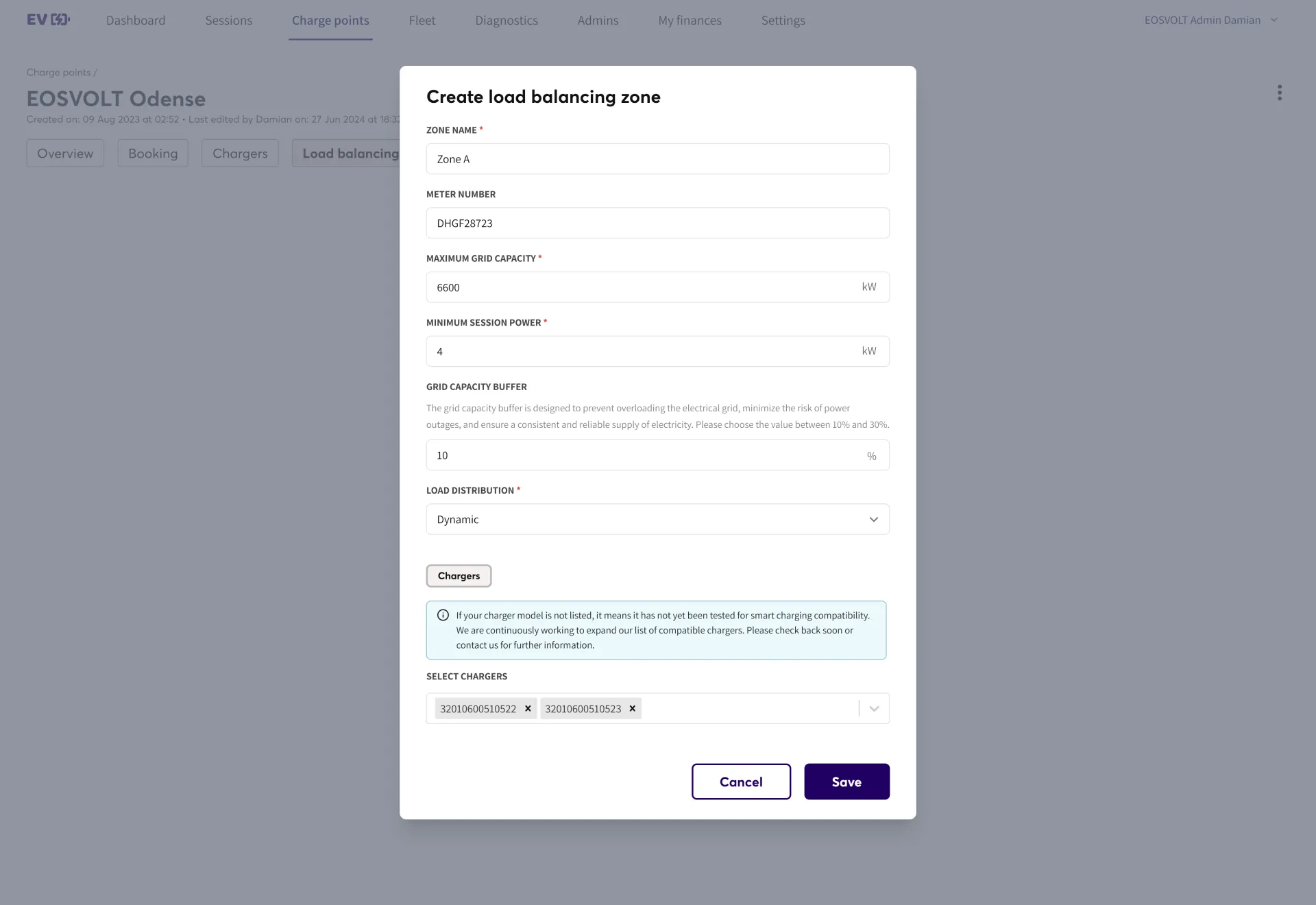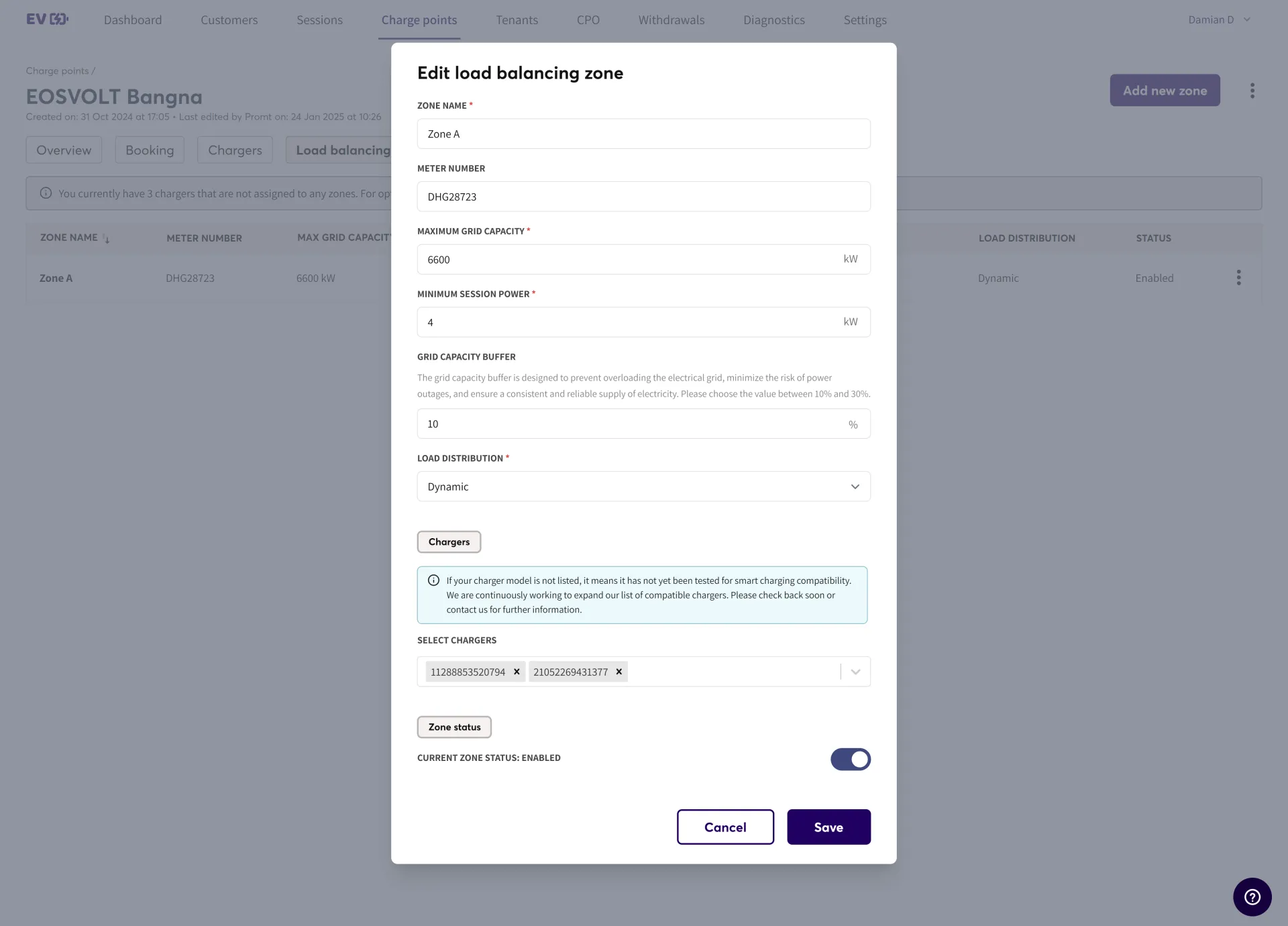Load Balancing
Load balancing is a feature designed to distribute available power efficiently among multiple chargers within a charging zone. It prevents overloading the grid and ensures that all connected vehicles receive optimal power while staying within defined grid limitations.
You can use dynamic load balancing to distribute power in real time while maximizing the site’s total charging capacity. Alternatively, sequential load balancing can be used to create a virtual queue — prioritizing users who arrive first and allocating remaining power to the next in line.

Load Balancing Configuration Fields
Zone Name
A user-defined name for the load balancing zone. This helps identify and manage different charging areas within a site.
Meter Number
The unique identifier assigned to the meter measuring power consumption in the load balancing zone. This number is provided by your electric utility.
Maximum Grid Capacity
The total power available for charging within the defined zone, measured in kilowatts (kW). This ensures chargers never exceed the site’s electrical capacity.
Minimum Session Power
The minimum power per charging session to maintain a stable and effective charge. This prevents extremely low power delivery that may not be beneficial for users.
Grid Capacity Buffer
A safeguard that reserves a portion of available power to account for fluctuations in the grid and other appliances on-site. Only the reduced portion of total capacity is allocated for charging.
ExampleIf the maximum grid capacity is 3600 kW and a 10 % buffer is set, only 3240 kW (90 % of 3600 kW) is made available for charging. This helps maintain stability and prevents overloads.
Load Distribution
Controls how available power is allocated to chargers within a zone.
Options
- Dynamic — Evenly shares available power across all active connectors, recalculating as sessions start/stop. Respects each connector’s configured max (and any per-session minimums, if set).
- Sequential — First-come, first-served virtual queue. Earlier sessions receive full power (up to connector limits) until the zone limit is reached; later sessions receive any leftover power or wait (idle) until capacity is freed.
Sequential Load Balancing (First-Come, First-Served)Sequential load balancing assigns site power in the order sessions start. Early sessions get full power (up to each connector’s limit) until the zone limit is consumed. Any remaining power is offered to the next session; if it’s insufficient to start meaningfully, that session waits (idles) until power is freed.
Key behavior
- First-come priority: Arrival order determines allocation.
- Full power until the limit: Allocate each active session at its configured max while capacity remains.
- Leftover power: Small remainders go to the next session if usable; otherwise it waits.
- Auto re-distribution: When a session ends, its power is reassigned to the next waiting session(s) in arrival order.
Recommended parameters
- Maximum Grid Capacity — Upstream site limit (e.g., transformer/main breaker).
- Grid Capacity Buffer — Safety headroom as a percentage.
- Zone Limit (computed) —
Maximum Grid Capacity × (1 − Buffer)
“Idle” means plugged in but not receiving power due to insufficient available capacity.
ExampleSite capacity: 100 kW Grid buffer: 10% → Zone limit: 100 kW × 90% = 90 kW Hardware: 6 × 22 kW AC chargers (1 connector each)
Allocation by arrival:
- Sessions 1–4 receive 22 kW each (total 88 kW).
- 2 kW remains.
- Session 5 receives 2 kW only if sub-rated allocation is allowed; otherwise it waits.
- Session 6 waits.
- When any of the first four completes, its 22 kW is reassigned to the next waiting session, preserving arrival order.
Use Sequential to create a predictable virtual queue while keeping the site within safe, stable limits.
Chargers
The list of chargers assigned to this load balancing zone. Only compatible chargers can be added. If a charger is not visible, it may not yet be tested for smart charging compatibility.
Select Chargers
Allows users to select which chargers will participate in this load balancing zone.
Zone Status Toggle
This toggle becomes available after a zone has been created. When enabled, all chargers in the zone operate under the configured load balancing rules. If disabled, the zone is deactivated and chargers will not receive power allocation from the balancing system.

TipUse this to temporarily pause a zone for maintenance without deleting its configuration.
Best Practices for Load Balancing Setup
Recommendations
- Ensure that the maximum grid capacity reflects the actual power available at the site.
- Set an appropriate grid capacity buffer to handle efficiency overhead and other equipment presented onsite.
- Regularly review and adjust configurations based on charging demand and grid stability.
Updated about 2 months ago
